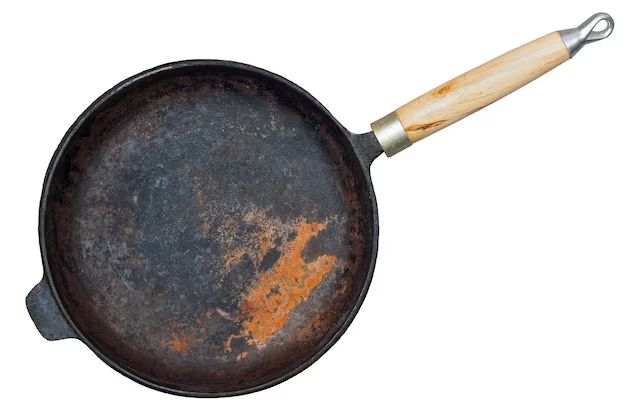Cast iron is a popular material for cookware due to its durability, heat retention, and natural non-stick properties. However, cast iron is prone to rusting if not properly cared for, especially when stored for long periods. Preventing rust on cast iron when putting it into storage requires a few simple steps.
First, it’s important to understand why cast iron rusts. Cast iron rusts when exposed to moisture. The iron in the cast iron reacts with water and oxygen to form iron oxide, which we see as rust. Rust can quickly damage the cooking surface of cast iron cookware, so preventing exposure to moisture is key.
Page Contents
Cleaning Cast Iron Before Storage
Before placing cast iron cookware into storage, it should be thoroughly cleaned and dried. Leftover food debris or oil on the surface can attract moisture and lead to rust. Here are some tips for cleaning cast iron before storage:
- Wash with hot water and a stiff brush. Scrub off any stuck-on food or grease.
- Dry completely with a towel. Make sure to wipe out any moisture from crevices and the underside.
- Optionally season the cooking surface. This provides a protective coating.
- Place cookware over low heat briefly to ensure it is bone dry.
Storing Cast Iron in a Dry Location
The storage location for cast iron is critical to prevent rusting. Cast iron should be stored in a dry, moisture-free environment. Here are some ideal places to store cast iron cookware:
- Inside cabinet: Place on a shelf inside a kitchen cabinet or pantry.
- Closet: Store on closet shelf or rod.
- Basement or garage: Choose a spot protected from humidity.
- Avoid outdoor sheds which can be damp.
Using Desiccant Packs
For added moisture protection, desiccant packs can be very effective when storing cast iron. Desiccants absorb ambient moisture in the air surrounding the cookware. Here are some tips when using desiccants:
- Place packs beside or underneath cast iron cookware.
- Use enough packs to create a moisture barrier.
- Replace desiccant packs every 1-2 months.
- Silica gel and calcium chloride are common desiccant types.
An example setup could include placing cast iron skillets in a plastic bin with a lid. Putting several desiccant packs in the bin creates added protection.
Creating a Protective Barrier
Creating a physical barrier around cast iron is another excellent way to prevent moisture exposure during storage. Here are some barrier options:
- Oil coating – Wipe a thin layer of vegetable or mineral oil to coat the cookware surface.
- Wax paper – Line the inside of cookware with wax paper before placing the lid on.
- Towels – Wrap cookware in a dry cotton towel or cloth.
- Plastic wrap – Cover cookware in plastic wrap or bag before storing.
Long-Term Storage Considerations
For storing cast iron longer than 1-2 months, take additional precautions. Prolonged exposure to moisture can still lead to rust over time. Tips for long-term cast iron storage include:
- Use a tightly sealed plastic bin or bag.
- Include multiple desiccant packs, replacing monthly.
- Wrap cookware in towel AND plastic for added barrier.
- Store in a low-humidity environment like a basement.
What Causes Rust During Storage
Understanding common causes of cast iron rusting in storage can help you prevent it:
- Moisture exposure from high humidity
- Contact with water droplets or steam
- Storing in a damp location like a shed or garage
- Putting away cookware when still wet
- Not using a protective barrier
Being diligent about proper storage methods and moisture prevention is the best way to keep cast iron rust-free.
How to Remove Rust from Cast Iron
If you open up your stored cast iron and find some light rust, don’t panic. Rust on cast iron can often be removed at home. Here are some DIY rust removal methods:
Steel Wool
Light rust can be scrubbed off using steel wool. Look for a fine grade like #0000 steel wool. Gently scrub the affected areas until the rust is removed. Wash, dry thoroughly, and re-season.
Vinegar
The acidity in vinegar helps dissolve rust. Soak a paper towel or cloth in undiluted white vinegar and lay it over rusted areas for 1-2 hours. Scrub with the soaked towel to remove rust then rinse clean.
Baking Soda
Make a paste with baking soda and water and apply to rusted spots. Let it sit for 15-20 minutes before scrubbing and rinsing. Baking soda is mildly abrasive to scour off rust.
Potato Halves
Rubbing rusted cookware with a halved raw potato can help loosen rust. The starch in the potato lifts rust particles. Rinse and dry completely after scrubbing.
Sandpaper
For more stubborn rust, use fine grit sandpaper (400+ grit) to sand away problem areas. Sand in the direction of the metal’s grain so you don’t scratch the surface.
For severe rust, you may need to re-season the cookware by coating it in oil and heating it in the oven to shore up the seasoning layer.
Tips for Preventing Rust After Storage
Once you take cast iron cookware out of storage, continue caring for it properly to prevent new rust from forming:
- Dry thoroughly after every wash.
- Apply a light coat of oil after drying.
- Don’t let water or foods sit too long on the metal.
- Avoid cooking very acidic foods.
- Re-season occasionally.
With vigilant care and storage, treasured cast iron cookware can last for decades without rust damage.
Conclusion
Rust can be detrimental to cast iron cookware, so proper storage is key. By cleaning and drying thoroughly before storage, keeping cast iron in a moisture-free environment, and using desiccants and protective barriers, rust can be prevented. Take extra steps for long-term storage beyond 1-2 months. If light rust appears, use DIY removal methods like steel wool, vinegar, baking soda or sandpaper. With diligent care and preparation, cast iron can be stored rust-free for the long haul.

